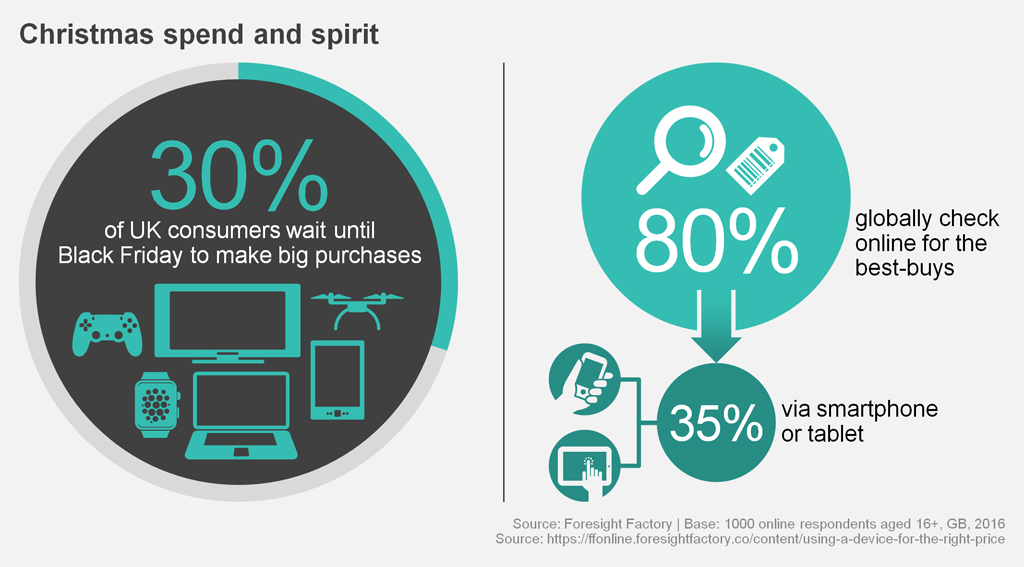The first in our three-part series on Local Perspectives: Christmas, Foresight Factory looks at consumer budget and gifts. Even if you’re working in the retail industry and already underway with your holiday strategy, it never hurts to take the temperature on how consumers really feel about Christmas retail and when people actually make their festive purchases. Turning to our global network of Trendspotters, this time from London, LA and Tokyo, we asked them all about spend and spirit in their respective parts of the world.
Black Friday and New Year for value gifts
Consumers around the globe are looking to capitalise on the best deals for their festive shopping. Even in the UK, a significant 30% of consumers agree that they wait until Black Friday to make big purchases, despite it being a traditionally American sales event. Also in the UK, three in ten adults say they “sometimes buy some Christmas gifts after 25th December to take advantage of the sales”, further exposing a desire to get the most out of their money. And plenty of resources are facilitating the hunt for optimal value: price comparison websites and the ability to check deals on-the-go are enabling the 80% of global consumers that have gone online to look for the best buys, with 35% of these queries made via tablet or smartphone.
“When choosing a gift I think price plays the biggest role.”
Kristin, 31, Los Angeles
“I get put off actually going to sales and seeing everything strewn everywhere, but buying online in the sale is pretty enjoyable! Makes you feel like you’ve got yourself a bargain.”
Charlie, 31, London
“In Japan, there aren’t really Christmas sales. People look forward to New Years sales, which are extremely popular and very important. There are limited edition products, discounted prices and other attractions for sales during this time. I think most people are looking to go on shopping sprees then, not around Christmas.”
Alisa, 25, Tokyo
It is no surprise that consumers choose to be price-savvy with their Christmas shopping, when one day of celebration is easily stretched over a month. Around one in ten adults in the UK claim to have had at least three Christmas gatherings, rising to 35% of millennials and those in the AB social grade.
However, it’s not all about consumers acting like Scrooge. There’s also a strong element of sentimentality and thoughtfulness that often overrides the need to splurge on the latest and most expensive gift on the market – just 17% of luxury items and 16% of tech products were either given or received during Christmas last year. Our Trendspotters highlight the importance of “the personal touch” when choosing a gift.
“I think choosing a gift is about getting that present you know the recipient will really love, and less about the commercial worth.”
Charlie, 31, London
“I do feel something with a personal touch is always nice. I try to give gifts like that that do have sentimental value or will make people laugh.”
Kristin, 31, Los Angeles

Wishlisting as a tool to avoid re-gifting
To avoid unwelcome surprises under the Christmas tree, consumers are making use of Wishlisting tools. Our Christmas research found that 16% of UK millennials have sent a weblink to their families or friends to make them aware of their desired gift. This trend shows that not only is the practice of ‘pinning’ or saving favourite items an enjoyable pastime in itself, it’s also a common pre-purchase behaviour.
In the run up to Christmas, social media conversation about wishlists peak, and has been on the rise since 2011, illustrating a steady growth in the activity. The most popular sites mentioned on Twitter and Instagram in this period include Amazon (which has a wishlist functionality) and YouTube – the latter pointing to the rise of vloggers and online influencers in guiding consumer choice. Aside from making it on the gift guides of traditional media publications, recruiting influential advocates online has become equally important (especially when targetting Gen Z).
“Oftentimes magazines will come up with suggested gift lists for the holiday season and they will include trendy items.”
Alisa, 25, Tokyo
“When receiving a gift it is nice to get something you really want (in my family we make lists) – but also I think it is really important to people these days that the gift is not useless/worthless e.g. going to end up shortly in the bin.”
Charlie, 31, London
“When receiving a gift, the biggest factor would be if it’s something you would actually use. We get so many gifts that we do not use or re-gift when people don’t know how to shop for us.”
Kristin, 31, Los Angeles
Handmade: budget or personal?
Handmade gifts are a popular talking point in the context of Christmas, but their appeal appears to be limited to certain demographics: one in five millennials gave one for Christmas, a similar figure to the percentage of children aged under five that did so too. One of the obvious reasons that come to mind is the significance of ‘the thought that counts’ when budget may not allow for a gift someone truly wants.
However, also driving the prominence of this behaviour among millennials is the trend The Leisure Upgrade, which describes how consumers believe that pairing entertainment with learning new skills or being creative holds valuable social currency. What better way to show off your new talents than by creating something unique and gifting it to friends and family?
However, this doesn’t mean DIY is in demand among all consumers groups – in fact, handmade items sometimes tend to be seen as inappropriate between adults, with retailer-driven personalisation often trumping truly handmade gifts.
“Personalized goods are popular, but handmade things are seen as a little old fashioned.”
Alisa, 25, Tokyo
“Handmade/personalised gifts are cute with children, e.g. I like receiving mugs or xmas cards they have designed, but I don’t feel like they are super popular between adults.”
Charlie, 31, London
What can brands do?
It appears that despite an unstable economic climate, consumer purchasing behaviour at Christmas isn’t hugely affected. Consumers will shop smarter but not necessarily spend less. Making it onto wishlists is as imperative as ever. This is especially as consumers are looking for worth and value and will be using wishlists increasingly as budgets tighten, to avoid receiving superfluous presents.
- Brands can guide wishlisting behaviour via virtual wish lists that can be shared will also provide consumers with social clout as they can show off their tastes and interests.
- Brands can look to YouTube and Instagram, and produce native content alongside influencer marketing to make it onto wishlists, particularly if the desired demographics are Gen Z and millennials.
- Introducing product releases after Black Friday with efforts to take advantage of wishlists could mitigate consumers’ preference to shop during the sale period.
- The increasing popularity of customisation facilitated by the commercial use of AR and VR is another point to capitalise on. Retailers could follow the examples from the beauty industry, encouraging DIY-loving consumers to opt for more ‘professional’ gifts without losing out on the desired personalisation.
While presents may be on everyone’s mind during Christmas, it’s not one of the top two reasons that consumers look forward to this season. Find out more in the next of our series on Local Perspectives Christmas: Food and Indulgence.
This is Part 1 of our Local Perspectives Christmas series
